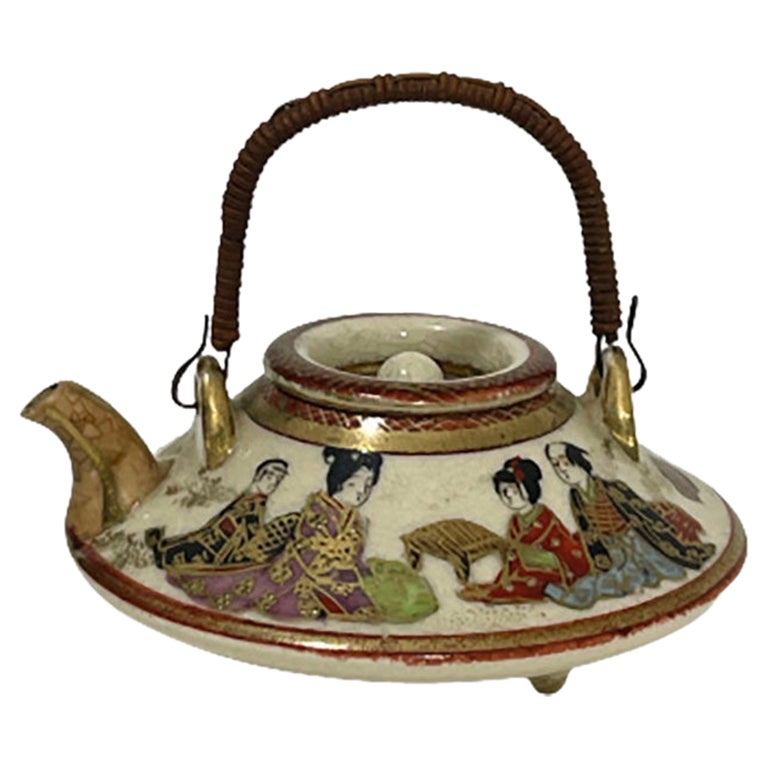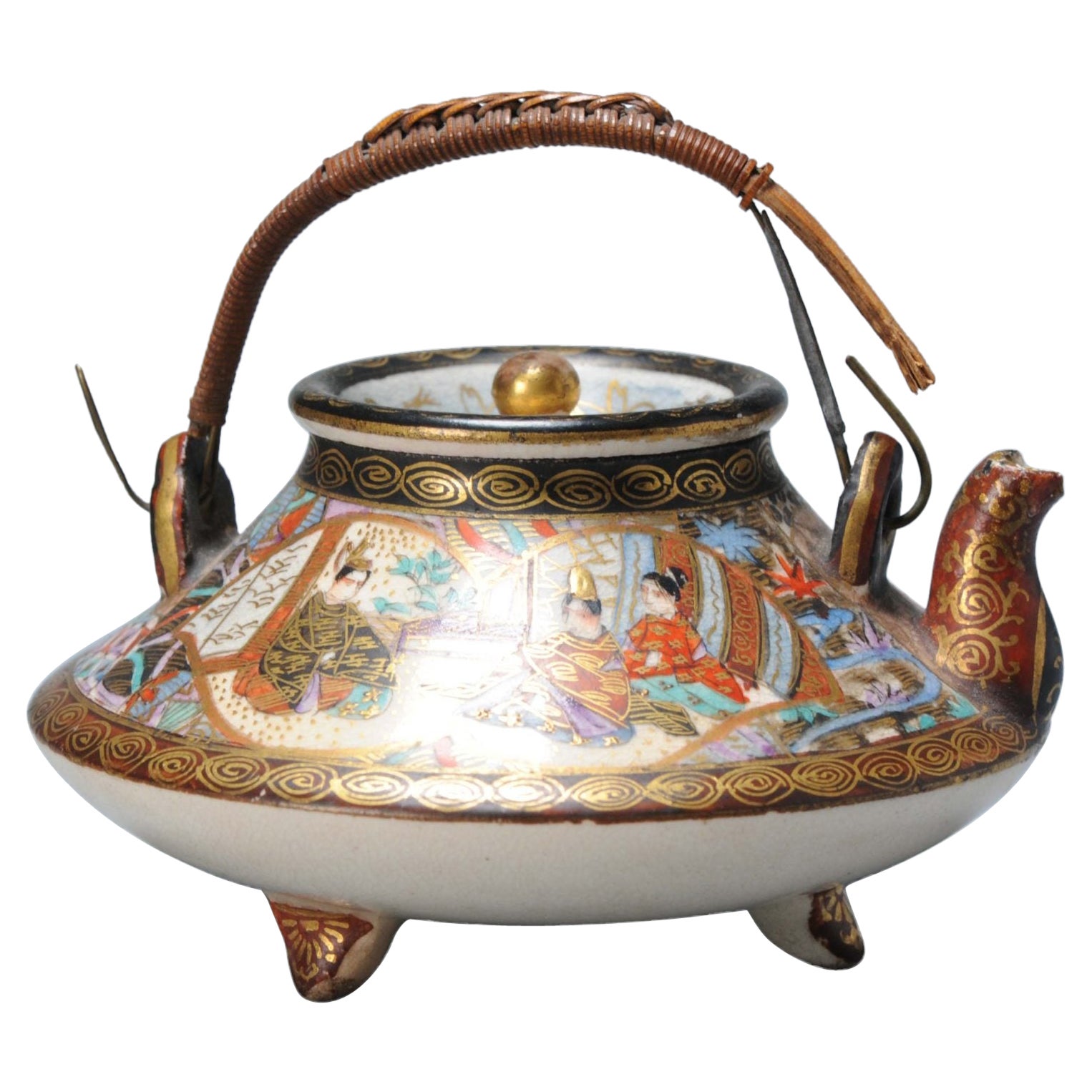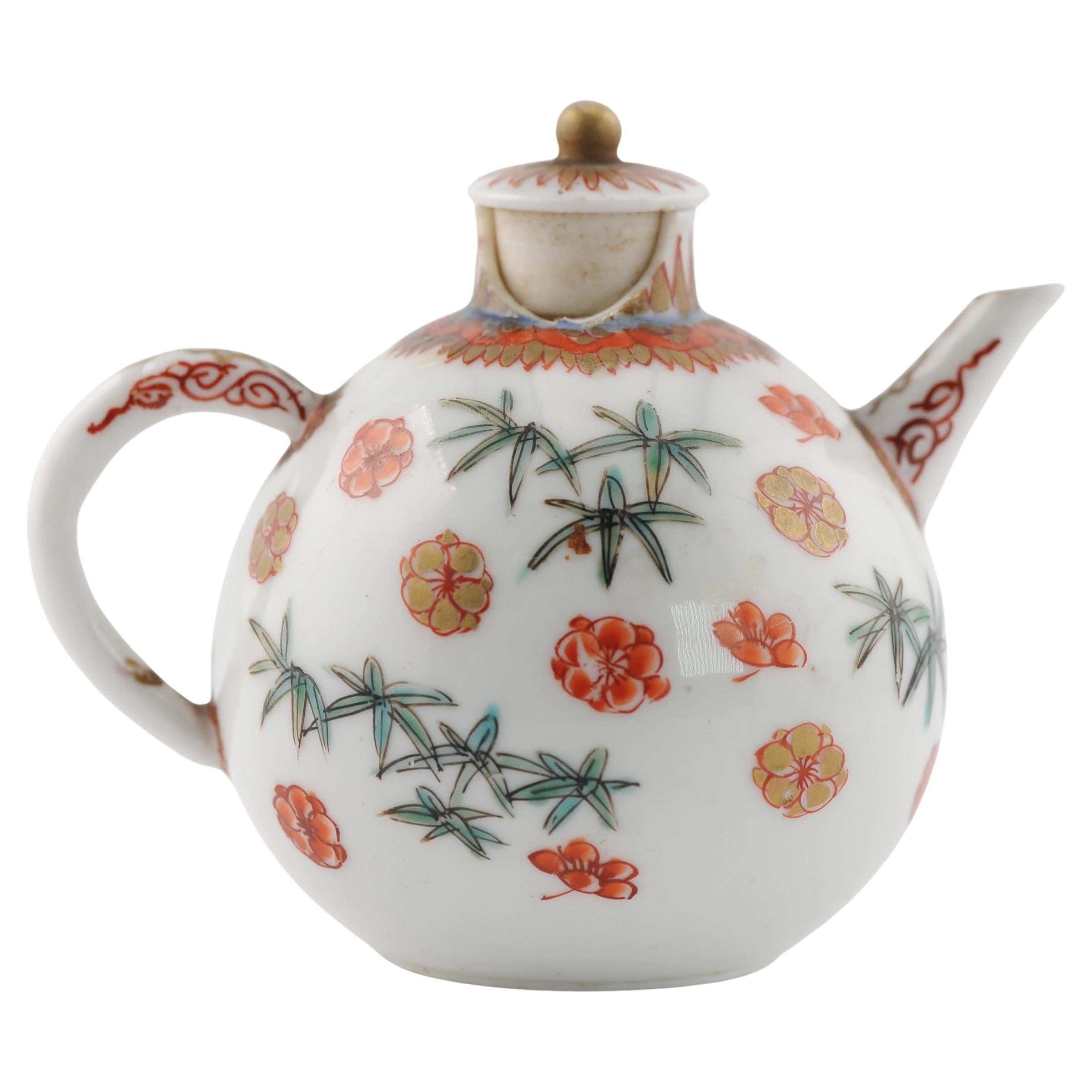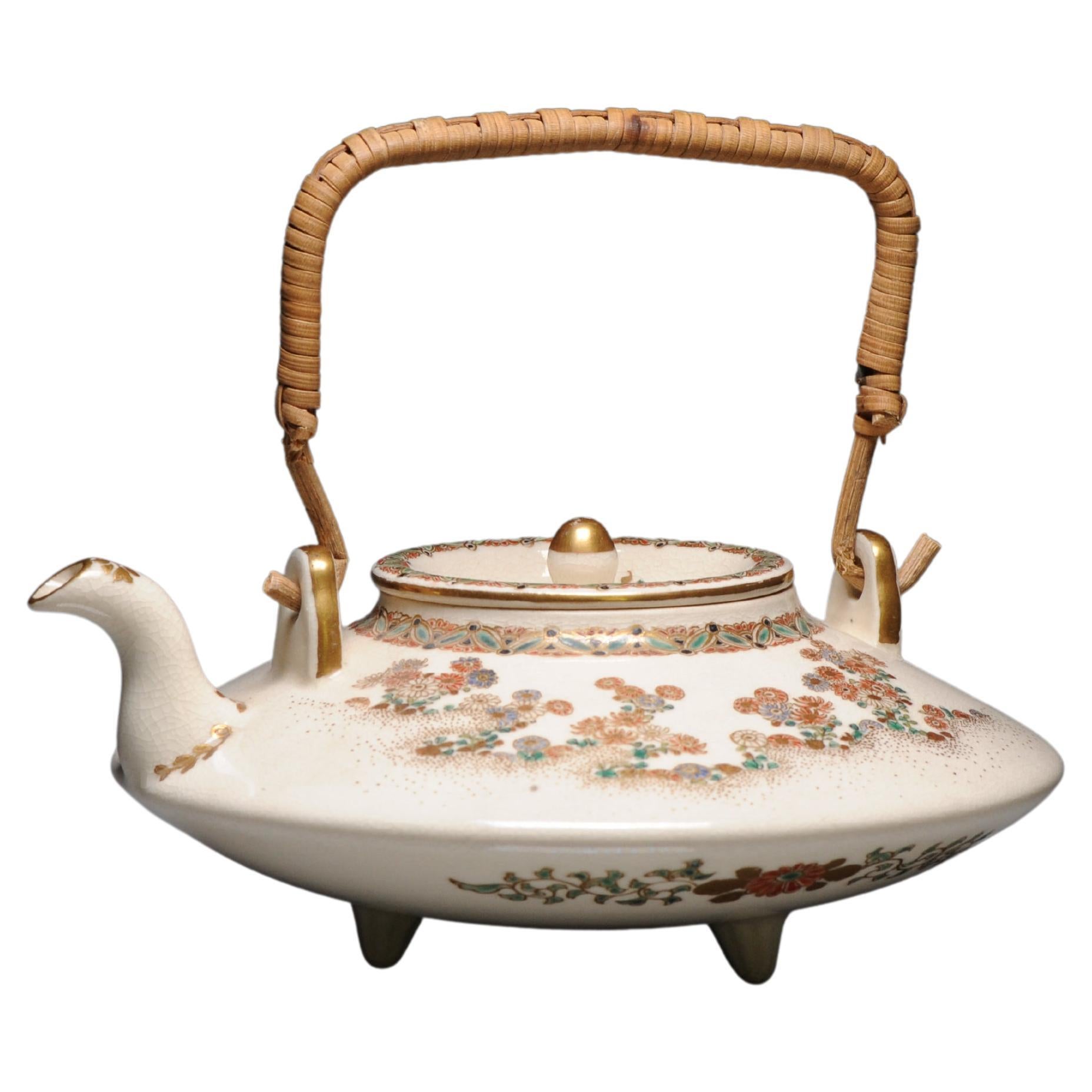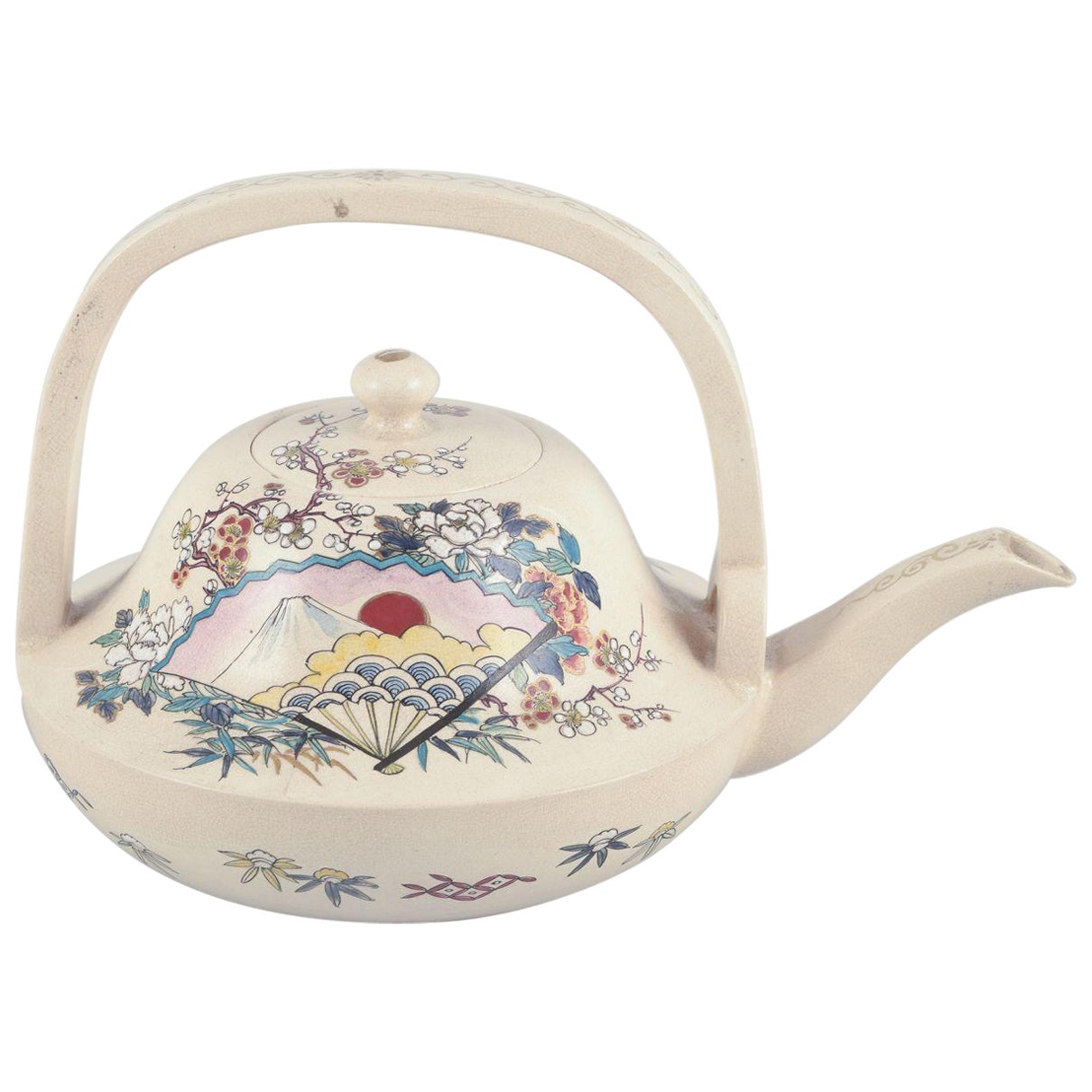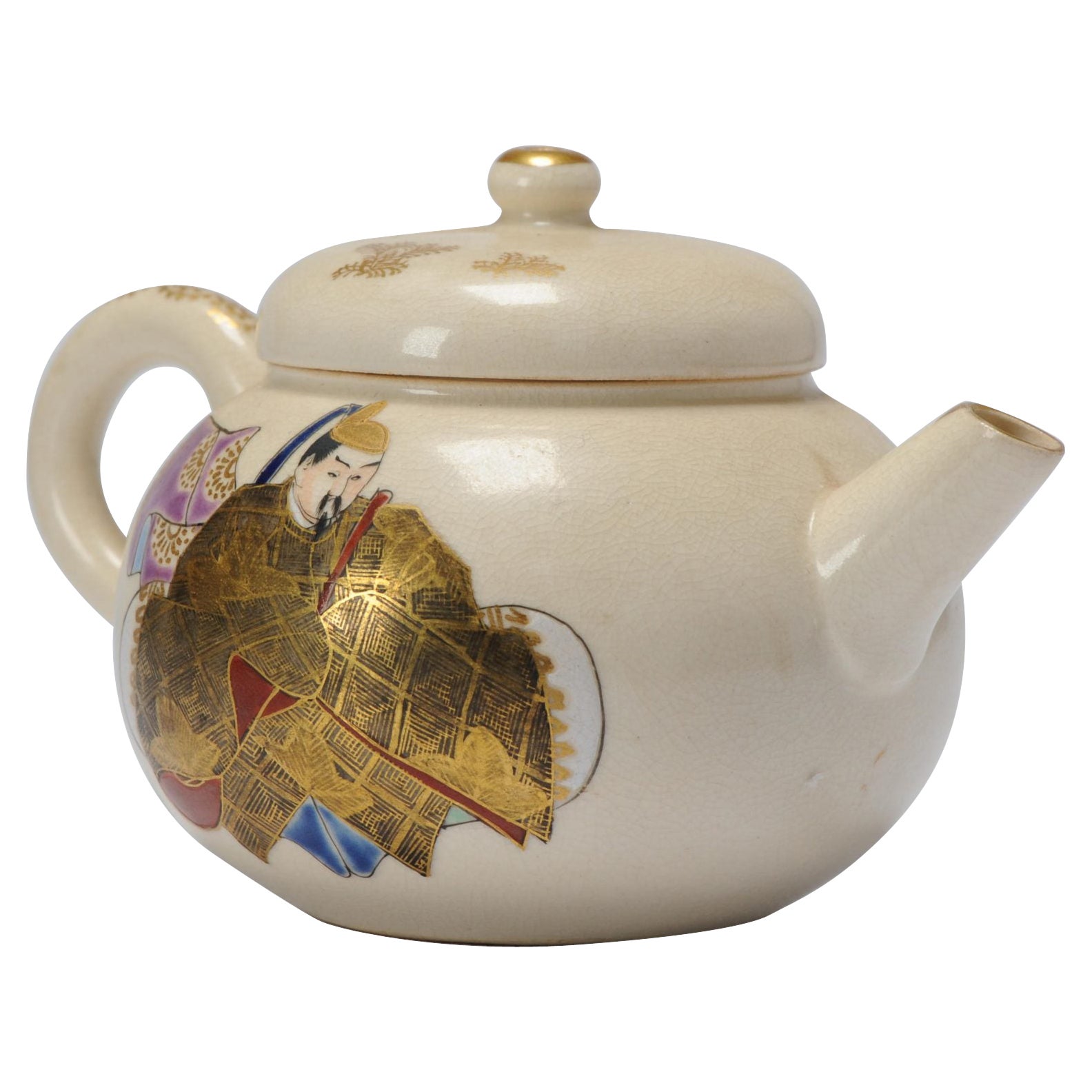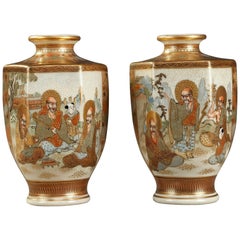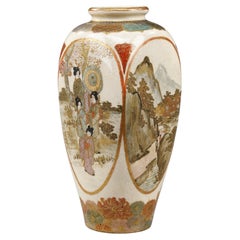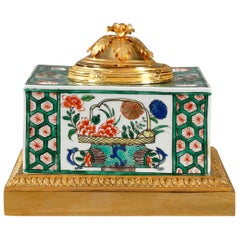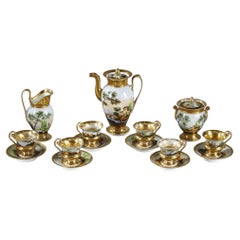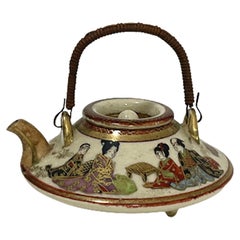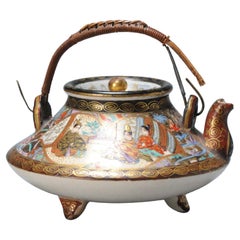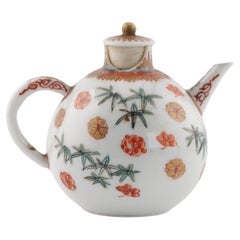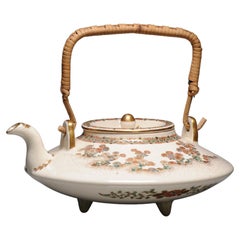Items Similar to Kyo Satsuma teapot and perfume burner by Kinkozan Kyoto
Want more images or videos?
Request additional images or videos from the seller
1 of 21
Kyo Satsuma teapot and perfume burner by Kinkozan Kyoto
$1,624.14per set
£1,203.57per set
€1,356per set
CA$2,217.25per set
A$2,466.60per set
CHF 1,293.02per set
MX$30,141.29per set
NOK 16,465.05per set
SEK 15,499.57per set
DKK 10,324.46per set
Shipping
Retrieving quote...The 1stDibs Promise:
Authenticity Guarantee,
Money-Back Guarantee,
24-Hour Cancellation
About the Item
Rare Satsuma porcelain set, consisting of a very small teapot with animated decoration and a tripod incense pot, with animated decoration on the outside. The pot has an openwork lid with floral decoration, and a flower-shaped handle. Label on the underside of the incense pot: Kinkozan Kyoto.
Documentation: The Kinkōzan were a famous family of Kyoto potters who made ceramics used in a temple linked to the imperial family in the Edo period. However, with the upheavals of the late Edo period and the subsequent reforms of the Meiji government, the potters lost their traditional patrons and had to develop new markets.
It was precisely at this time that a visit from a certain Westerner is said to have prompted them to start trading abroad. By 1870, they had perfected the Kyō Satsuma glazing technique, and in 1872 began exporting on a large scale.
The Kinkōzan continued to expand their business throughout the Meiji period, to the point where Kyō Satuma production surpassed the original Satsuma made in Kagoshima.
Numerous collections of Kyoto Satsuma in Europe and the United States testify to Kyō Satsuma's success on the export market.
Teapot dimensions: 9.5 cm : 9.5 cm : 9.5 cm
Pot dimensions: 9.5 cm : 9.5 cm : 9.5 cm
- Dimensions:Height: 3.94 in (10 cm)Width: 3.94 in (10 cm)Depth: 3.94 in (10 cm)
- Sold As:Set of 2
- Materials and Techniques:
- Place of Origin:
- Period:
- Date of Manufacture:1890
- Condition:Wear consistent with age and use. Wear to decoration.
- Seller Location:Paris, FR
- Reference Number:Seller: 34631stDibs: LU2065341205982
About the Seller
4.9
Gold Seller
Premium sellers maintaining a 4.3+ rating and 24-hour response times
Established in 2001
1stDibs seller since 2016
323 sales on 1stDibs
Typical response time: 2 hours
- ShippingRetrieving quote...Shipping from: Montesson, France
- Return Policy
Authenticity Guarantee
In the unlikely event there’s an issue with an item’s authenticity, contact us within 1 year for a full refund. DetailsMoney-Back Guarantee
If your item is not as described, is damaged in transit, or does not arrive, contact us within 7 days for a full refund. Details24-Hour Cancellation
You have a 24-hour grace period in which to reconsider your purchase, with no questions asked.Vetted Professional Sellers
Our world-class sellers must adhere to strict standards for service and quality, maintaining the integrity of our listings.Price-Match Guarantee
If you find that a seller listed the same item for a lower price elsewhere, we’ll match it.Trusted Global Delivery
Our best-in-class carrier network provides specialized shipping options worldwide, including custom delivery.More From This Seller
View All20th Century Pair of Small Porcelain Satsuma Vases
By Satsuma
Located in Paris, FR
Two porcelain hexagonal Satsuma vases painted in polychrome enamels and gold. The paunch is decorated with intricate Japanese characters in a landscape, the neck and the shoulder wit...
Category
Antique Early 19th Century Japanese Japonisme Porcelain
Materials
Porcelain
Satsuma porcelain vase from the Meiji period, Japan
Located in Paris, FR
Small porcelain vase in Satsuma earthenware. The 4-sided body is decorated in polychrome and gold enamels with geishas in a garden, a mountain landscape, a bird on a flowering branch...
Category
Antique 1890s Japanese Ceramics
Materials
Porcelain
Famille Verte Porcelain Inkwell by Samson
By Samson & Cie
Located in Paris, FR
Small famille verte porcelain inkwell decorated with enameled flowerpots, foliage, and stylized rinceaux. The inkwell is set on a gilt bronze b...
Category
Early 20th Century French Chinoiserie Inkwells
Materials
Enamel, Bronze
Paris porcelain service with landscape decorations
Located in Paris, FR
Paris porcelain set: tea or coffee service, composed of several decorated pieces:
- A coffee or tea pot with gilded lid and carved spout.
- A milk jug with open spout and elegant han...
Category
Antique 1820s French Porcelain
Materials
Porcelain
Tea Service with Sevres and Château des Tuileries Marks
By Manufacture Nationale de Sèvres
Located in Paris, FR
Tea service tête à tête in porcelain bearing the initials of Louis-Philippe in a garland of laurels. The service is composed of a tray, a teapot, two cups with their saucers, a milk ...
Category
Antique 19th Century French Louis Philippe Tea Sets
Materials
Porcelain
19th Century Small Inkwell in Porcelain and Silver-Gilt in Sevres Style
By Manufacture Nationale de Sèvres
Located in Paris, FR
Small inkwell crafted in porcelain, the paunch and lid decorated with a frieze of polychromatic floral motives highlighted with gold. The lid topped by a pine cone finial features a ...
Category
Antique 19th Century French Louis XVI Inkwells
Materials
Silver
You May Also Like
Japanese Satsuma Miniature Tripod Teapot and Cover, Meiji Period
Located in Delft, NL
Japanese Satsuma miniature tripod teapot and cover, Meiji period
A circular flattened form miniature teapot with cover painted in enamels and gilt...
Category
Antique Late 19th Century Japanese Antiquities
Materials
Earthenware
Antique Meiji Period Japanese Satsuma Tea Pot Japan, 19th Century
Located in Amsterdam, Noord Holland
Faboulous japanese earthenware Teapot of unusual shape.
Additional information:
Material: Porcelain & Pottery
Type: Tea/Coffee Drinking: Bowls, Cups & Teapots
Japanese Style: Satsum...
Category
Antique 19th Century Japanese Tea Sets
Materials
Porcelain
$850 Sale Price
20% Off
Miniature Antique Edo Period Early 18th Century Japanese Porcelain Teapot
Located in Amsterdam, Noord Holland
Description
Miniature Teapot.
Sharing with you this lovely and small sized teapot from the early 18th century. The shape and design are lovely and unusual. The base is unglazed.
See...
Category
Antique 17th Century Edo Decorative Dishes and Vide-Poche
Materials
Porcelain
Antique ca 1900 Japanese Satsuma Taizan Teapot Richly Decorated Marked
Located in Amsterdam, Noord Holland
Japanese Satsuma vase, Meiji period
of ovoid form with slightly domed cover, decorated with monkeys in robes frolicking in a landscape beside a river.
Condition
Overall Conditio...
Category
Antique 19th Century Japanese Meiji Ceramics
Materials
Porcelain
$1,627 Sale Price
20% Off
Satsuma, Imperial Japan. Miniature teapot in earthenware. Approx. 1870s
Located in København, Copenhagen
Pre-owned goods are exempt from import duties for U.S. customers.
Therefore, no import tariffs will be applicable to your purchase.
Satsuma, Imperial Japan.
Miniature teapot in ear...
Category
Antique 1870s Japanese Tableware
Materials
Earthenware
Antique Signed Satsuma Teapot Fujiware no Teika, Late 19th/Early 20th Century
Located in Amsterdam, Noord Holland
A lovely Satsuma Teapot. Marked on body and lid + pot rims. So, the teapot depicts the author Fujiwara no Teika (the text to the right reads, "Counselor...
Category
Antique Late 19th Century Japanese Tea Sets
Materials
Porcelain
$718 Sale Price
20% Off
More Ways To Browse
Perfume Set
Kyoto Furniture
Rare Perfume
Teapot Flowers
Perfume Collection
Large Teapots
Teapot Japan
Large Japanese Pot
Japanese Porcelain Pot
Rare Antique Teapots
Rare Flower Pots
Japanned Tripod
Antique Japanese Teapots
Porcelain Perfume
Japan Temple Flowers
Large Incense Burner
Small Incense Burner
Antique Japanese Flower Pot
